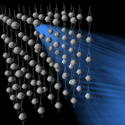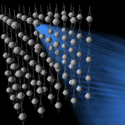Where are the neutrinos?
Gamma-ray bursts are the most luminous objects in the universe for the few brief seconds that they shine. Theory predicts that a fraction of their enormous energy should be coming out in neutrinos. However, as reported in Physical Review Letters, a search at the world’s largest neutrino detector at the South Pole has come up empty, which rules out certain gamma-ray burst (GRB) models.
GRBs result from a giant star explosion or the collision of star remnants. These cosmic cataclysms produce—in addition to gamma rays—high-speed protons that are thought to account for the highest energy cosmic rays observed on Earth. Near the source, these protons may run into photons and end up generating neutrinos with energies far above . In the past, neutrino detectors on Earth have not been large enough to capture one of these high-energy neutrinos with any likelihood.
IceCube, which was completed in December 2010, is a kilometer-cubed array of photodetectors that have been drilled down into the Antarctic ice cap. Neutrinos typically fly through the array without leaving a trace, but occasionally one will collide with a nucleus and create a charged particle that emits light as it moves through the ice. The IceCube team compared months of their data (collected when the array was half finished) to observations of GRBs measured independently over the same time period. Contrary to expectations, no high-energy neutrinos were detected within a half-hour of each GRB. Theorists may need to rethink their models of GRBs, as well as look for other possible sources for the highest energy cosmic rays. – Michael Schirber





